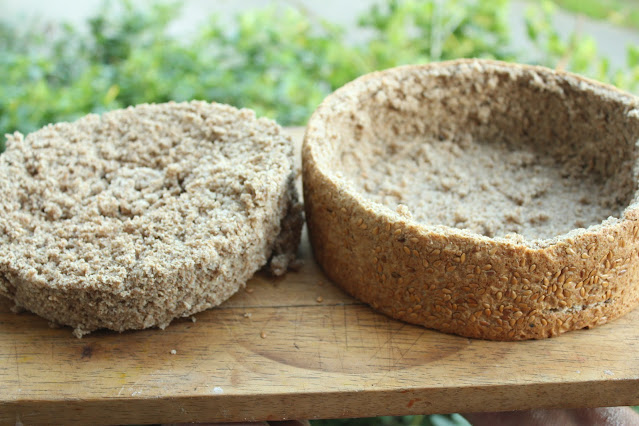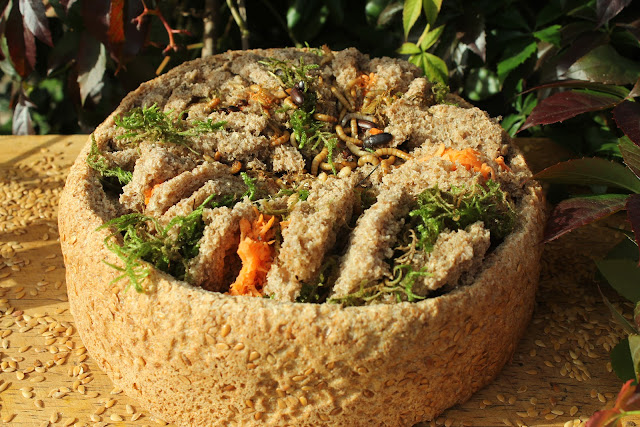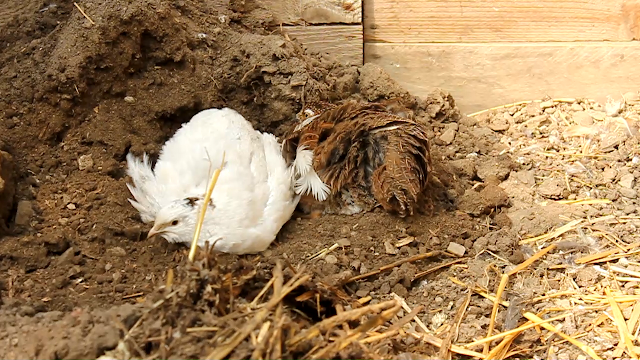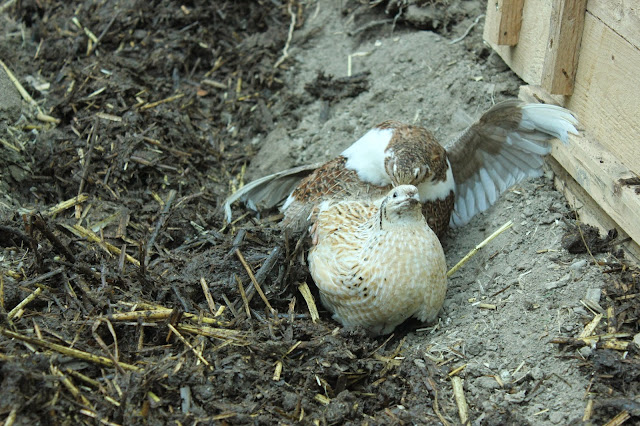Pain Surprise is an elegant way of serving a selection of sandwiches, usually at weddings, picnics and parties, wherein the loaf itself becomes the presentation dish. On the table, the bread looks quite ordinary but then the lid of the loaf is lifted to reveal the 'surprise' within, dainty triangles of delicious sandwiches. However, in this version the 'surprise' has something a little extra and is strictly for the birds.
I've been raising organic mealworms for some years, mainly for our quail. This year I have had a bumper amount of mealworms hatching and pupating due to the continuous hot Summer weather, so they are in need of a new home.Lately I've been giving the worms some stale bread crust, which they really enjoy but I also realised how spooky the crusts looked as the mealworms hollowed them out. I even found some of the mealworms had tunnelled out little 'nests' within the crusts in which to pupate. Then I was given some organic bread flour to make loaves for my chickens from friends who also, on account of the very warm Summer, have had big problems with mites in their shop. The photo on the left shows an example of the Indian meal mite lava found in the bag of flour I used for this loaf.
The organic linseed was provided by the same source and for the same reason - although our mealworms are not that keen on linseed but I thought it looked more festive.
I foraged the moss from our local forest and the carrots were rejects, again from the organic shop.
The total cost of this project was $3 for the second-hand aquarium.
Ingredients
8 cups - 1 kilo - 2lbs whole-wheat flour
2 teaspoons of quick yeast
2½ cups - 600ml - 1 pint+ of luke warm water (you may need a little more or less water depending on your flour)
Seeds - I used a handful of linseed
Butter/fat for greasing tin
Choice of sandwich fillings - I chose traditional green and orange.
Your choice of creepy crawlies.
Ribbon and optional decorations - I used a brooch and a piece of black hat veiling.
Equipment
Mixing bowl (pre-warmed)
Damp dish/glass cloth
Round loaf/cake tin 9" - 22cm diameter and 4" - 10cm deep
Slightly larger tin or pan
Sharp bread knife
Shallow bowl for rolling loaf in seeds
Aquarium (I got one at a secondhand shop for $3). This is optional but if you are putting your Pain Surprise on an actual dinner table then it could a good idea!
Making the Loaf
Sieve the flour into a pre-warmed mixing bowl.
Add the yeast and mix well into the flour.
Add the water slowly, mixing as you go - flours differ and some need more or less water than others.
Knead dough for between 5 to 10 minutes, until it is smooth and elastic.
Shape into a ball and place into the lightly greased mixing bowl.
Place in a warm area, cover with a damp cloth and leave to rise until it has doubled in volume.
Prepare the cake/loaf tin by lightly greasing with butter or fat.
Punch back the dough and knead for a few minutes.
Shape it into a loaf using the tin as a guide to size.
Sprinkle a handful of seeds into a shallow bowl and then place the dough, crust-side down into the seeds. Then using your hands, pat some seeds up onto the sides of the loaf.
Place loaf in the tin.
Score the top of the loaf with a sharp knife.
Leave in a warm place to rise to the top of the tin (30 to 40 minutes)
In the meantime preheat oven to 400ºF or 200ºC.
Bake until the loaf freely leaves the sides of the tin, when turned upside down. This is approximately after 30 to 40 minutes in the oven.
As an extra check, tap the base of the loaf with the knuckles. If there is a hollow sound, then the loaf is baked.
Place right side up on a cooling rack.
Preparing the Loaf
When the bread has completely cooled, place it in a slightly larger tin. This tin will be used to both prevent the seeds being disturbed on the sides of the loaf and also to maintain the crust at a high enough level to cut off the 'lid'.
Using the rim of the tin as a support for your knife, gently remove the top crust.
Wholemeal bread is quite crumbly, so go slowly when you remove the crust and also make sure your knife is very sharp.
Place your lid to one side on a drying rack and place the rest of your loaf on another rack. Leave to dry.
The object now is to remove the whole of the inner cylinder of bread aka crumb, whilst leaving the base and side crusts intact.When your loaf is dry to the touch, take a sharp knife and make an incision all the way down and around the loaf 'crumb' at ½ " or 1cm from the side, making sure not to pierce the bottom crust of the loaf.
Pierce the crust with a sharp thin knife, at ½ " or 1cm from the bottom of the loaf, making an incision wide enough to take your bread knife. Insert the bread knife and carefully, with a sawing motion, angle the knife through the incision to slice through and along the bottom of the loaf, making sure not to pierce the crust nor make the original incision any larger. You may need to reverse the knife to cut out an exact circle. Or you could make two incisions and cut both ways to avoid leaving some of the crumb behind.
Use your fingers to remove the bread cylinder aka crumb.

Place the crumb in the freezer - this will make it much easier to slice.
Making the Sandwiches
Remove the crumb from the freezer.
Using a sharp knife and with the crumb placed on its side, carefully split it into an even number of slices.
You can make these as thin or as thick as you like. Thicker is easier! You may even find it simpler, depending on the depth of the crumb to make just one row of sandwiches - doorstops as they are called where I come from.
Make your sandwiches from your filling and two rounds of bread - my fillings are green and orange - traditional Halloween colours.
Cut each round of sandwiches into triangles.
If your bread is really crumbly, then an alternative way is to cut the sandwich triangles first and then split them afterwards.
Pain Surprise
Place the first circle of sandwiches slightly at an angle back into the crust container, so that the filling is showing.
Add the creepy ingredient.
Continue onto the next layer, sandwiches and crawlies, until the Pain Surprise is full.
Place the crust lid on top and tie with a ribbon.
Add Halloween decoration.
Prepare a few days in advance for a better effect at the reveal.
Place the Pain Surprise in an aquarium or similar glass bowl with a lid so as to avoid any escapes.Thanks for dropping by and do feel free to share experiences or ask for further information in the comment section. If you have enjoyed this piece and found it useful think about sharing it with your family and friends, on social media and also maybe about joining this blog and/or subscribing to my Youtube, Odysee or BitChute Channel or even supporting us on Patreon or
Until next time, all the very best from sunny Normandie!
























